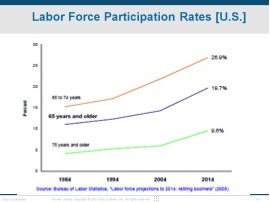This post was started in 2010 in Australia, when I was asked to speak at the biennial world meeting of the International Federation on Ageing (www.ifa-fiv.org/) and the World Health Organization. They were interested in my early work on socio-economic trends in this networked age.
I don’t like giving packaged presentations and much prefer to talk about things that have some meaning for the audience. So I did some research on aging and tried to work out in my mind what are the implications of the growing digital network on the way that we live longer.
This post is a summary of that thought process.
First consider the traditional view of aging, perhaps more prevalent in the general public than among experts.
Basically, as you get older, this view says you will get increasingly debilitated and immobile, have to retire from the work force, become dependent upon government financial support and personal service from others, and spend much of your time in medical facilities. There is no doubt that some of these things can happen and eventually the body does wear out.
But is this a necessary picture of aging in today’s world? Not when people can be connected by broadband networks that, increasingly, include video capabilities which really make it feel that you are together with others who are far away.
First, let’s deal with the dissociation from the work force. In 1900, 71% of the American labor made goods or food. This was often back-breaking work, the kind of job that indeed did become untenable for the elderly.
But, by 2000, only 21% of American workers are still in the business of making goods or food. The rest provide services, increasingly intangible services that are created on computers and delivered over the Internet.
One of the consequences of this is that many people no longer go to a job. Their work goes to them wherever they might be. It is so common that people are working at home or in locations outside of the offices of their employers that many companies have found they need half the space per employee that they did ten years ago.
So when people are faced with reduced mobility, whether it is due to a skiing accident or the aging of the body, it no longer means that they cannot work and earn a living.
Is this relevant to seniors? The Pew Internet and American Life Project has found that 41% of those over 65 are online. Among the next wave of potential retirees, those between 50 and 64, 74% are online.
Even a couple of years ago, you could find a story about “Seniors finding social networking exhilarating” (from The Dallas Morning News, October 12, 2009). And many of us have seen grandparents connect with the grandkids via videoconferencing and social media.
Ok, you might say, that seniors might be able to work, but do they want to or do they wish to just live off their savings and government help?
In an article entitled, “Successful Seniors Who Won’t Retire”, Business Week featured 105 seniors a couple of years ago who won’t quit, with Jane Fonda as the prime example.
There have been recent research studies about this very question. Labor force participation by seniors has gone up in recent decades.

In another Pew study, they reported that 12% of current retirees already work for pay. More than three quarters of current workers expect to work for pay after retirement – 60% because they want to and only 30% because they have to work to make ends meet. The authors conclusion:
“The latest Pew findings suggest that retirement is a phase of life about which public attitudes, expectations and experiences are in a period of transition.”
This is not just an American phenomenon. Xinhua News reported:
“About one third of the retired people in Beijing want to keep on working to earn more and to stay in touch with society.”
Although age discrimination is widespread in hiring, it is counter-productive. Other research has found that “Older Workers Had Higher Educational Attainment Overall Than Older Non-workers.”
Of course, those people, no matter what their age, who have higher education are more likely participants in the knowledge economy – the intangible, digital part of the economy. Thus the labor force participation rate of those with advanced degrees was about three times that of those with less than a high school education.
But what about the disabilities that seem to be part of aging?
Among those who work with seniors, there has been a movement called “universal design” whose aim is to ensure that every room in a home or other building is designed with ease of use. For example, look at the work by the NCSU Center for Universal Design (http://www.design.ncsu.edu/cud).
Their goal for seniors is to prevent accidents, like slipping in a shower. (The point has been made, of course, that these improvement also help those who are no so old. Anyone can slip in a shower if it’s not properly designed.)
In this century, we can do more than be careful with traditional physical design.
There has been much in the news lately about the “Internet of things”, which is a phrase that describes the increasing number of sensors and other devices without direct human interfaces all over the world, including in our homes.
This enables architects to design a blended virtual/physical environment for seniors that can monitor their safety and health. For example, it is possible to build in prevention and detection of falls among seniors.
Being always connected can mean always having access to tele-health. I’m thinking of what exists now. There are all sort of devices to monitor chronic diseases, which means that doctors can remotely diagnose and catch problems early before they become critical and expensive.
These devices allow for a range of options for senior, instead of unnecessary commitment to a long-term care facility.
In the future, sensors that transmit from inside your body and that help repair your body will become available and take tele-medicine to an extraordinary new level.
The connectivity of seniors at home can also lead to better health outcomes as was demonstrated in the Vermont Telecare for Rural Health Project. They ran a successful, multi-way interactive tai-chi exercise class for those over 70 who did not leave their homes. As the leaders of the project noted:
“We know that exercise is helpful for senior patients, but we can’t get to them. And we know that Tai Chi helps keep seniors healthy, increases their well-being and balance.“
So even home-bound seniors with chronic diseases can still participate in the economy and the wider society.
Ok, you might say, we can overcome some of the physical handicaps that sometime accompany aging. But what about the mental degradation? the intellectual stodginess that is part of the common view of the elderly? Aren’t seniors unprepared to participate in an economy in which innovation is a critical element of competitive success?
In many, these views are misleading or irrelevant in this century. Let’s start with the irrelevant by observing our own children and how they use the Internet.
Is a quick and expansive memory for details something they cherish, even among themselves, when there is the Internet to look up almost any fact?
Is it necessary to worry about reminders when "there’s an app for that”?
But the misleading part of this view is more interesting, if less well known.
There was a time that it was assumed that only the very young were creative. However, there has been more recent bio-medical research on the resilience and continuing growth of the brain even among older people.
There was also the interesting research by the economist Galenson who focused on artists, among others. In a review of Galenson’s work, Gladwell, writing in the New Yorker magazine, asked: “why do we equate genius with precociousness?"
Galenson divided creativity into two types – conceptual and experimental. The complete conceptual revision of some domain, be it art or physics, is often associated with the very young.
The experimental or experiential type of creativity is evidenced by those much older since it is based on the ability to make connections among diverse experiences that only older people have had. It is also based on a lifetime of experimentation with the world.
In discussions of innovations in business and in driving future economic growth, it is this kind of creativity that makes the most difference.
But there is a catch, which is why many are misled about this subject. The catch is that creativity is a collaborative act. It is not about some lone 20 year old genius sitting on a mountainside. As Steven Johnson put it in his book "Where Good Ideas Come From”:
“That is how innovation happens … chance favors the connected mind.”
No matter what someone’s age, if they are not in the stream of new ideas, they will not achieve their creative potential. Unfortunately, for most people, they are exposed to new ideas and knowledge less and less for each year they are away from college or their last formal educational experience.
Some colleges, for example Purchase College of the State University of New York, have admirably tried to remedy this by enabling seniors to audit classes for a very low fee. But classroom instruction is expensive and not always convenient for seniors.
The Internet, however, has a vast potential to put seniors back into that stream so that they too can be innovative. MIT has put its courses online, among other universities. Carnegie-Mellon is leading an open learning project. Florida has a virtual reference librarian available 24 hours a day. There are training videos and tutorials in almost every subject imaginable.
Especially interesting is the cooperative, free online university for seniors – University for the Third Age (U3A).
There is just a tremendous amount of scientific and other research that used to be available only on the campus where it occurred or later in scientific journals and conferences. Now much of that is available online. And local librarians can help people find this, if it becomes too daunting to search through for an individual.
Public leaders in the 19th century recognized the economic importance of ensuring that all citizens could read and they created the public schools and libraries necessary to achieve that goal. In this century, public leaders need to ensure that residents of all ages are helped to identify where they can get 21st century learning.
Another significant socio-economic trend in this century is the increased recognition of the role played by new entrepreneurs in economic growth – and the way that the Internet makes it easier than ever to start up a business.
Thus, there is no reason that this greater entrepreneurial opportunity cannot be grabbed by a 59 year-old as much as 19 year-old almost-college-dropouts. Apparently, this is something that older people realize. The Kauffman Foundation highlights its finding (http://www.kauffman.org/research-and-policy/kiea-interactive.aspx) that the
“increasing rate of entrepreneurship among older adults has led to a rising share of new entrepreneurs in the fifty-five to sixty-four age group. This age group represented 14.5 percent of new entrepreneurs in 1996, whereas it represented 22.9 percent of new entrepreneurs in 2010.”
As we enter into the world of ubiquitous communications in this century, we will find that the traditional issues which have handicapped older people are diminishing. This should generate a whole new way of looking at them and at this part of life – not a phase of debilitation and near vegetation, but an active life despite whatever limitations the aging body may impose.
This new outlook may be represented by a new equation, with apologies to Einstein, e = (mc)² Enhancement of life experience results from more connectivity which leads to more choices.
© 2012 Norman Jacknis
[http://njacknis.tumblr.com/post/20006652147/living-long-in-a-networked-age]



